Do Not Sleep Here
“Today, you dead,” the Cambodian soldier hisses into Matt Dillon’s face and throws the American actor to the ground of a dilapidated room.
Seconds later, James Caan and a group of gangsters shoot it out on a patchy lawn in front of a dark, imposing building, while doom-laden fog drifts up from the surrounding jungle, threatening to swallow the protagonists, dead or alive.
That was in 2001, in Matt Dillon’s thriller ‘The City of Ghosts’. While the plot was tardy and the protagonists two-dimensional, the locations had a brooding menacing presence, filled with tension and despair.
No wonder – the movie’s key scenes were shot around the old casino Le Bokor Palace, a long-abandoned French hill station a thousand meters above the Cambodian coastline, until now at the centre of a national park.
Five years on and several horror films later, little appeared to have changed around the hill station in late 2007.
Vichat, a ranger who’d been working in the national park for the past three years, did not dare to go inside the casino at night, “Every time we walk past we can hear the dead walk in there. It’s full of ghosts.”
A big sign in the casino’s lobby warned all visitors ‘Do not sleep here’. But the fog of war is soon to turn into history – late last year, a Cambodian company landed a concession to redevelop the hill station, build a golf course and resurrect the casino for a new generation of high rollers.
In February 2008, the road to one of Cambodia’s most unique monuments and national parks was blocked
Bokor Hill Station, in its heyday, was Cambodia’s most luxurious colonial hide-away, as well as an imperial folly – hotels and dance halls, a church, a royal villa, restaurants, servants’ quarters and a water-tower that appears to have walked straight out of a 1950s cold war sci-fi picture must have made for an incredibly exclusive ambience in such an incredibly remote location.
The crowning glory of this community in the clouds was the casino hotel, a towering monument to France’s vain glory.
The construction of this most unusual holiday resort came at a price – more than two thousand Cambodians are said to have died during the building of the road up from the coast, which snakes through forty kilometers of dense, forbidding jungle. Since then, the killing around Bokor has never really stopped.
France quit Indochina in 1953, its taste for colonial adventure gone after being expelled from Vietnam by Ho Chi Minh’s communists.
The half century since has been anything but kind to Cambodia – accumulated decades of suffering from US bombing and civil war, the Khmer Rouge genocide, a Vietnamese invasion, famine and chaos have crushed the country and its people.
But there are some positive changes afoot. Cambodia is currently observing a shaky peace, the temples of Angkor have enjoyed a half decade of solid growth in its visitor numbers, now in the millions.
The rest of the country is catching up – very, very slowly.
Cambodia’s south-eastern corner – the lush tropical coastline dotted with relics of colonial power like the beach resort Kep, Bokor Hill Station and the provincial capital Kampot – is also coming back to life.
Besides Angkorian temples, ruins of a more recent past – the French buildings – are virtually the only structures still standing at the close of Cambodia’s half century of conflict.
Bokor Hill Station may not be able to compete with the marvels of Angkor, but the traces of colonial dreams and the faded charm of L’Indochine are present everywhere along Cambodia’s coastline.
Unfortunately, what’s left of Cambodia’s French heritage is crumbling from lack of attention. Old town houses and administrative buildings in the capital Phnom Penh and elsewhere are being knocked down to make room for modern buildings.
For the Cambodians, the remnants of old foreign structures hold no meaning beyond their current utility and the French have little influence today. Restoration is not on anybody’s mind.
Cambodia wants to move on, wants to be part of the 21th Century.
“I get five dollars to look after this rich man’s property. I’m a government soldier. I used to fight against the Khmer Rouge in those hills behind us until a few years ago. Now I have nowhere to live, no money. So I look after the house.”
Mr. Long is standing on ‘his’ property’s drive-way, opposite Kep’s crab market. The soldier’s temporary home, once a modest villa, is now little more than a concrete shell, with blown-out windows and missing ceilings. Kep’s other 300 or so buildings look the same.
The French built a few villas in Kep in the 1920s. In the 1950s Cambodia, Kep-Sur-Mer, 40 kilometers below Bokor Hillstation, was the place to go, the weekend get-away for the rich Khmer ruling class, who felt stifled by the turgid heat that gripped the capital Phnom Penh half the year. On the beach front Cambodian aristocracy rubbed shoulders with American film stars. It wasn’t Saint Tropez or Cannes (there was no sand on the beach – not until King Sihanouk had it had to be shipped in from Sihanoukville), but it must have been a picture of tropical tranquility and luxurious bon vivant nonetheless.
Now cows and pigs meander along the overgrown roads and the beach front is lined with overgrown villas and holiday homes. It’s quiet on the disused lanes and Kep has the air of a post-apocalyptic archeological site, silently displaying remnants of a modern society ground to pieces.
Five minutes up the hill, cocktails are once more shaken and stirred at the bar of the Verandah Resort – one of a handful of smart hillside bungalow properties that have recently opened in Kep. French wines, Italian pizzas, world music and sunset views are on offer – bohemian chic for the 21st century traveler looking for soft adventure – Kep is the very definition of soft adventure.
And it is safe. In contrast to many other parts of the country, Kampot Province has a very low numbers of landmines and UXO left in the ground. Hence, walks through eerie stripped-down beachfront properties and eating delicious steamed crabs are the town’s main draw.
Yet Kep remains remote, not quite connected to the world yet – there is no Internet, no bars have opened outside the resorts, electricity is intermittent and the main road through town is likely to be as crowded with playing children and sleepy bovines as with traffic at any time of day. This may change. Visiting Europeans are slowly waking up to early 20th Century nostalgia. European-run guesthouses and restaurants are springing up all over the area, not least in the near-by picturesque provincial capital, Kampot.
Things are less straight forward at the Bokor Casino. The ghosts of war have not yet faded from the mountain top.
Vichat, the park ranger, never leaves his office without his gun, “We have problems with poachers who come to take trees out of the national park, sometimes to shoot animals too.”
Vichat only earns 17.000 Riel a month, hardly an incentive to risk your life against desperate intruders. The US-NGO Wild Aid, active in Bokor Park since 2002, is supplementing his meager earnings and has provided training for more rangers. The rangers, like Vichat, are all armed and have the power to arrest poachers. But the park area is huge and there are few trails.
Vichat is cautiously optimistic, “We have managed to reduce the logging significantly. And in May 2006 a tiger was spotted near the Wat, right on top of Bokor Mountain. But these sightings are very rare nowadays. Too many people come and go.”
A small but steady trickle of tourists, mostly on trips in pick-ups organized from Kampot, has been visiting Bokor Hill Station. The journey was not an easy one, as the road up from the coast was potholed all the way. Up top, facilities were minimal. The ranger’s station offered dorm beds but no food. The colonial ruins were as they had been for years. Dormant and spooky.
Says Vichat, “There was fighting here until quite recently. The Khmer Rouge were holed up in the casino in the early 80s and fought the Vietnamese who had taken the church. Later the Khmer Rouge fought government troops from the casino.”
Standing in front of the Bokor Casino Hotel in the late afternoon is plain creepy. The windows are all shattered and loom like black holes from of the building. The walls of the Casino are covered in red moss that looks like freshly congealed blood. The Victorian turrets, the broken balustrades, the rusty water tanks and the broken toilets look sinister, only the gargoyles are missing.
The front facade of the casino appears to lean towards and over the visitor as one approaches, eager perhaps to offer a Mephistophelean bargain suite. From an overgrown forecourt, a wide staircase leads into a yawning doorway. Beyond, corridors and narrow stairways lead off into darkness. No fixtures, but psychic ones remain. The fireplace in the ball room has been smashed to pieces, bathtubs and toilets have been ripped from their foundations, mirrors smashed and electrical wires have been chiseled out of the walls and carried off. Graffiti, much of it explicitly vulgar, covers the walls of the suites and hallways. ‘Everyone died’, one reads in English. Some of these scrawls were left behind by Khmer Rouge fighters, most have been added by tourists since.
The traces of war are pervasive. Many balconies are still protected by leaking sandbags and old rusty shells litter corners of the property.
From the roof, reached via a series of long, empty corridors and partially collapsed stairways, the church, the post office and the other buildings are all visible. Beyond the main buildings, service quarters and a royal villa lie hidden in the jungle. Deeper still, an hour walk away, the remnants of a prison where the French kept Cambodian prisoners, is still standing. But everything is broken, falling down, beyond repair. No wonder the rangers don’t like to wander at night.
On New Year’s Eve 2005, several thousand tourists and young locals gathered at the Bokor Casino for a dance party. During the night, an argument between Cambodian police officers turned violent, and several men pulled their guns. Two of the men succumbed to their injuries. The darkness unleashed by the violent dissolution of civil society sticks to everything in Cambodia.
Bokor is a special place. The area has been designated a national park and precious jungle surrounds the former hill station. Poaching is under control and tourists have begun to discover the area, bringing much needed currency to the park and the coastal communities of Kep and Kampot.
This should protect the area from commercial exploitation, but the planned redevelopment of the Casino Hotel will most likely put an end to nature’s recovery. The reconstruction of the road and the planned building of an 18-hole golf course will have a huge impact on this wilderness area. Given that the redevelopment plan is fielded by a Cambodian company, that all negotiations were conducted in secret and that the potential clientele of the to be opened resort will be well-heeled Asian golfers and gamblers, the lingering French charm, the uniquely eerie atmosphere and the relatively undisturbed biodiversity are bound to disappear.
Some voices call for abandoning the renaissance plans for Bokor, but development is virtually unconditional in Cambodia and neither the country’s impoverished and uneducated population nor the government have the time or inclination to protect the colonial heritage or the natural resources Bokor has to offer.
The ghosts of war, as well as the jungle, may soon make way for the 18th hole and the Black Jack table.
My original feature on the Bokor Casino first appeared in Fortean Times.
Postscript: Work on the road to Bokor began in 2009 and access has been on and off. A second road is being cut through the dense jungle and work on new infrastructure on the Bokor plateau is said to start soon. The only sure way to reach the casino at the moment is on foot, a gruelling six hour walk through the jungle. A guide is recommended.
More of my Bokor images at flickr.


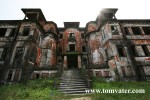
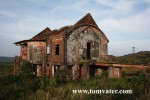
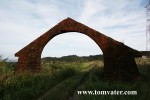
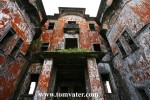
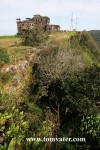
H Steve,
Thanks for the missive and the awesome article attached. Much appreciated.
yo bud,
guess you did not know but the Bokor Palace Hotel was never a casino. Sihanouk built a casino up there but not within the hotel, he built a separate building opposite the ranger station, it was a flop and probably the only casino in history to run at a loss.
cop some of this, a review of the casino in june 1963.
http://www.fileden.com/files/2009/2/12/2318217/bokor63.pdf
Eery experience no doubt. Great place to see for those who like to travel down the less beaten path.
Thanks. I have been back again and again in the last ten years. Exhilarating as well as haunting experience. It can be really spooky up there, when the fog comes in and the ghosts move across the tall grass. It will be interesting to see how much the current resort development will affect the ruins and the national park.
Bokor does sound like special place. I will have to go and have a look for myself. Great photos Tom.